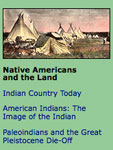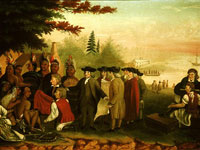The greatest factor allowing Europeans to gain a foothold in North America had nothing to do with good planning. The colonization of the Americas by Europeans was built on the aftermath of disease. Old world illnesses such as influenza and smallpox wiped out 90% of the pre-contact population of the Americas within 100 years of Columbus landing in the Caribbean. In Meso-America, Nahuatl-speaking people remembered that, "Before the Spaniards appeared to us . . . an epidemic broke out, a sickness of pustules. Large bumps spread on people; some were entirely covered. They spread everywhere, on the face, the head, the chest, etc. The disease brought great desolation; many people died of it . . . And when things were in this state, the Spaniards came" (). Disease reached the region we now call Virginia long before John Smith, and disease was one reason the Native communities of the area entered into confederation with one another—to protect themselves from incursions by the Spanish, who they knew brought illness with them.
Similarly, when the first Pilgrims reached New England in 1620, they stepped into a world where up to 90% of the local people had recently died, probably from the bubonic plague. The psychic, spiritual, material, and political effects of such staggering losses cannot be overstated. The indigenous people of the Americas were often in no position to insist that Europeans leave.
Alliances with the Native people who remained were, however, essential if colonists hoped to survive the rigors of new environments.
Alliances with the Native people who remained were, however, essential if colonists hoped to survive the rigors of new environments. The Mattaponi people of Virginia recalled that English colonists didn't bring enough food with them to feed themselves, and the ships' manifests reveal that too many of the colonists were gentlemen, and too few were laborers, resulting in a lack of knowledge and skill to adequately plant and bring in a harvest. The colonists initially knew little about the soil or climate of the places in which they hoped to live. Without Native knowledge—such as the advice to bury dead fish as fertilizer in New England soil—colonists would have starved. As it was, they faced their own battles with malnutrition and disease, and here the Pilgrims may have done better than the Virginians—the former, at least, had sufficient women in the party to take charge of the washing, cooking, and healing that was necessary to survive the rigors of American life.
Why did Roanoke colony fail? It was, like later English colonies, poorly supplied, and the first colonists were actively hostile toward local Native people. This lack of allies would have made survival as an autonomous community especially difficult—surviving as distinctly Englishmen and women may have been impossible. Some historians theorize that the colonists left Roanoke and were absorbed into local Native communities in small groups. If we judge success in terms of an individual's survival, this was a successful tactic. If we judge success by the establishment of long-lasting English colonies on American soil, then Roanoke failed.


